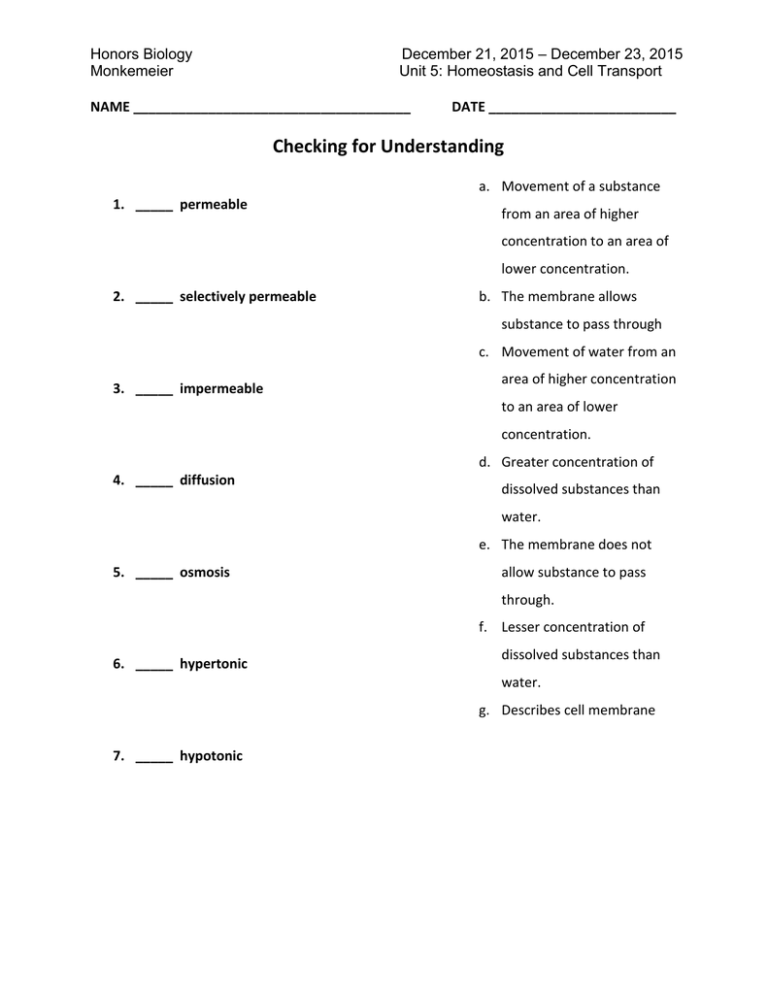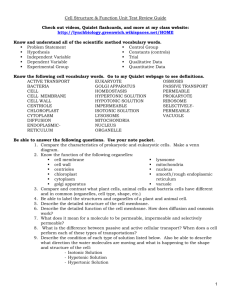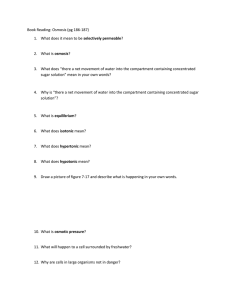– December 23, 2015
advertisement

December 21, 2015 – December 23, 2015 Unit 5: Homeostasis and Cell Transport Honors Biology Monkemeier NAME _____________________________________ DATE _________________________ Checking for Understanding a. Movement of a substance 1. _____ permeable from an area of higher concentration to an area of lower concentration. 2. _____ selectively permeable b. The membrane allows substance to pass through c. Movement of water from an 3. _____ impermeable area of higher concentration to an area of lower concentration. d. Greater concentration of 4. _____ diffusion dissolved substances than water. e. The membrane does not 5. _____ osmosis allow substance to pass through. f. Lesser concentration of 6. _____ hypertonic dissolved substances than water. g. Describes cell membrane 7. _____ hypotonic Honors Biology Monkemeier December 21, 2015 – December 23, 2015 Unit 5: Homeostasis and Cell Transport Define the following terms in your own words. Do not copy the definition from a resource or internet source. 1. Concentration Gradient:_____________________________________________________ ____________________________________________________________________________ 2. Passive Transport:____________________________________________________________ _______________________________________________________________________________ 3. Isotonic:____________________________________________________________________ ______________________________________________________________________________ 4. Why does the cell membrane need to be permeable to substances used as nutrients? 5. Why do you think oxygen and carbon dioxide can easily diffuse across the cell membrane? 6. Examine the diagrams of plant cell and animal cells below. The words hypotonic and hypertonic must be used together to describe the cell and its environment. The words above each cell describe the extracellular fluid (environment). a. Draw an arrow to the inside of each cell and label it with the correct description: isotonic, hypertonic, hypotonic. b. Label the animal cells correctly using the words: lysis and crenated. Honors Biology Monkemeier December 21, 2015 – December 23, 2015 Unit 5: Homeostasis and Cell Transport Sources for Images https://internalandexternalenvironments2012.wikispaces.com/Hypertonic,+hypotonic+and+isotonic+effects+on+ plants+and+animal+cells. http://microscopy4kids.org/Osmosis ACTIVITY – VIEWING PLANT CELLS Observing Elodea/ Water Plants (Turgor Pressure, Plasmolysis) Materials: Microscope Microscope Slide/ coverslip Leaf from water plant (elodea) in a fresh water environment Eye dropper with tap water Leaf from a fresh water plant (Elodea)placed in a salt water environment Procedure: 1. Create a wet mount slide of a leaf from the water plant in a fresh water environment. 2. Use the scanning objective lens to find the leaf, center it and to focus. 3. Switch to low power objective. View the cell wall and locate the large central vacuole and chloroplasts. Create a labeled sketch of the field of view. PAY ATTENTION to the SIZE of the Large Central Vacuole. 4. Using the field of view measurement to be about 1.5 microns, estimate the size a cell from this plant. 5. Switch to high power objective. View the cell wall, locate the large central vacuole and chloroplasts. Create a labeled sketch of the field of view. 6. Repeat steps 1 through 5 with a leaf from the same plant but from the salt water environment. PAY ATTENTION to the SIZE of the Large central vacuole. I. DATA – use the space below for your labeled drawings and for your calculations for estimating the size of a plant cell. Honors Biology 2015 Monkemeier December 21, 2015 – December 23, Unit 5: Homeostasis and Cell Transport





